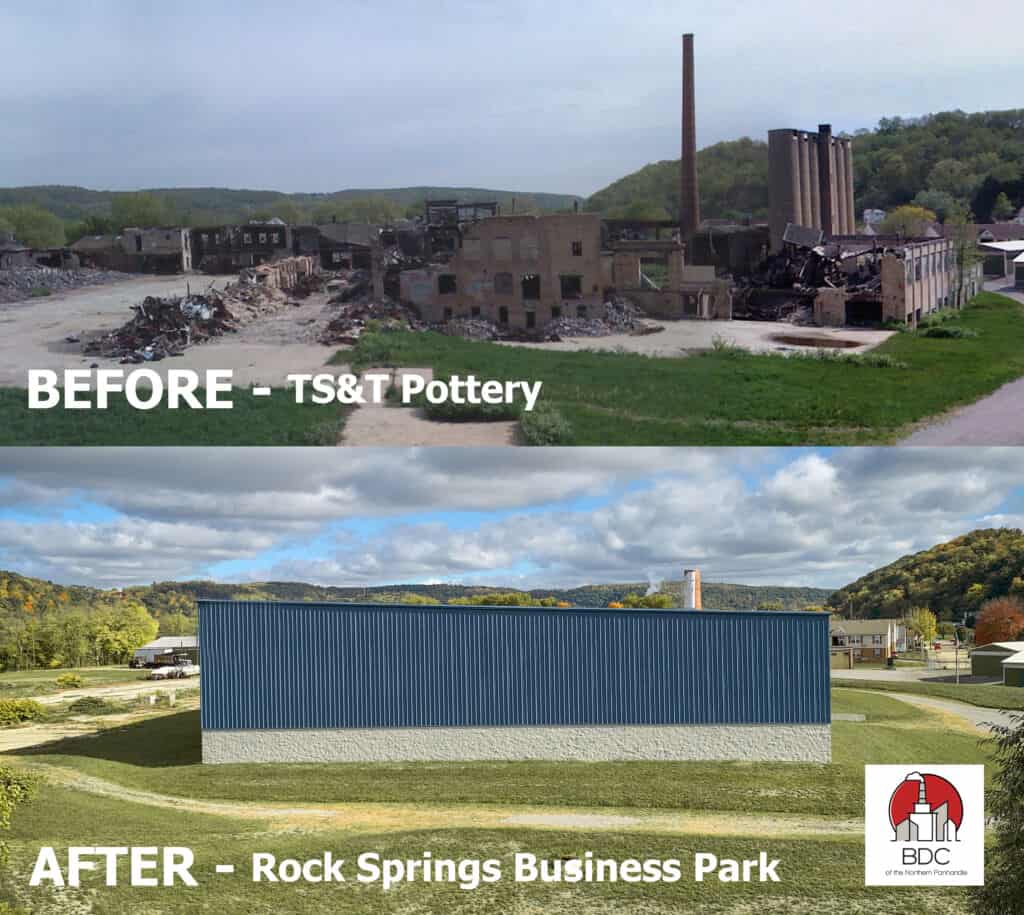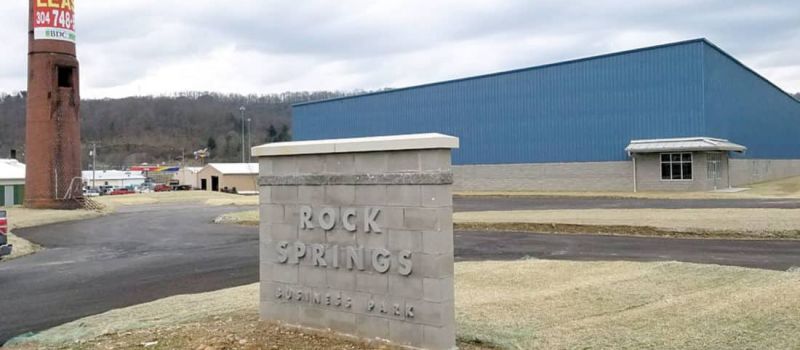The TS&T Story
Taylor, Smith, & Taylor Company (TS&T) was in operation from 1900 until 1981 in Chester, West Virginia. Like many other potteries in the early 1900s, TS&T made dinnerware, hotel ware, toilet sets, and specialty pieces. By the late 1930s, the plant focused solely on dinnerware, including LuRay Pastels. TS&T was purchased by Anchor Hocking in 1972 and continued to produce dinnerware until it closed in 1981.
Five West Virginia Governors promised that the hazardous site would be demolished and redeveloped, but 30 years after its closing, TS&T still stood decaying on Chester’s riverfront.
Lead, ceramic debris, and asbestos thwarted attempts at the renewal of the site-until a $5,000 FOCUS Grant from the Benedum Foundation through the Northern WV Brownfields Assistance Center encouraged the Business Development Corporation (BDC) of the Northern Panhandle to acquire the site. The investment was leveraged into $ 1.1 million, allowing the BDC to raze the remaining structures and remediate the land.
The project was one of four projects highlighted in the Claude Worthington Benedum Foundation 2010 Annual Report, Building Strong Communities. The project also won a competitive grant from the WV Redevelopment Collaborative that was awarded to communities facing complex brownfields projects.
The TS&T Site
Located along the Ohio River in Chester, West Virginia, the former TS&T Pottery Site now presents an opportunity for a dynamic brownfields redevelopment.
By reclaiming the nine acres that comprise the TS&T site, the BDC, and the community are poised to develop the site with a mix of uses that sustain the community for generations.
Suggested and market-supported uses range widely, but generally focus on job creation, including light industry, commercial, and accessory open spaces.
The BDC worked with the WV Development Collaborative to develop a master plan for the site. This collaborative allowed WVU professors from eight academic disciplines to assist the BDC with branding, community engagement, visioning, sustainability, and market analysis.

June 6, 2018
Rock Springs Business Park issued certificate of completion by state EPA

CHESTER — Following almost seven years of work, the Business Development Corp. of the Northern Panhandle has reached a milestone with its first major development project.
The West Virginia Department of Environmental Protection has issued a certificate of completion to the BDC for the Rock Springs Business Park, formerly the site of the Taylor, Smith and Taylor pottery factory in Chester.
The certificate of completion, issued May 25, validates the site now is clear of contamination and better suited for future redevelopment.
The BDC purchased the former pottery property in July 2011, demolishing much of the factory, rehabilitating the soil and recently constructing a building suited for potential tenants. It was the economic development agency’s first major project in the area.
“We got all of our scars on this one,” BDC Executive Director Patrick Ford said, noting each lesson learned on the project has been emulated on every other brownfield project the agency has undertaken.
Brownfields are former industrial or commercial sites where future use can be affected either by real or perceived environmental contamination.
Private banks and investors typically do not get involved in financing contaminated properties because of the high potential risk, Ford explained. Those who do work to clean up such a site have to perform their due diligence to know what risks exist before moving forward. They also should be willing to enroll in West Virginia’s Voluntary Remediation Program, which is run by the DEP and monitors cleanup efforts, Ford added.
There are 70 projects currently in the VRP and each project is limited in how much funding it can receive each year from various sources, meaning economic development groups often have to look to multiple funding opportunities.
“The average brownfield property requires 14 funding streams to clean up,” Ford said.
For the Rock Springs Business Park, the BDC tapped into 19 funding streams from seven sources — much of it grant programs — including the Benedum Foundation, the U.S. Environmental Protection Agency, the West Virginia Economic Development Administration, the West Virginia Brownfields Assistance Center, the West Virginia Community HUB program, the Hancock County Commission and its own coffers.
Having the certificate of completion, Ford said, can open the door for private investment for the site. It also creates a covenant preventing any future legal claims against the BDC pertaining to previously existing contamination.
Completing the cleanup of this site, as well as continuing efforts at brownfield sites in Beech Bottom, Follansbee, Wellsburg and Weirton, Ford said he sees the area becoming more attractive for potential development opportunities related to the energy, chemical and value-added metals industries.
“We’re getting these cleaned up in time to absorb the demand,” Ford said.
CHESTER – The next chapter in the reclamation of the old Taylor, Smith & Taylor pottery site began Thursday morning with the shoveling of dirt under a cloudy sky.
The drizzle did not dampen the spirits of those in attendance at the long-anticipated groundbreaking ceremony.
“I’m so happy,” said Chester resident Mary Lawrence, an early proponent of the TS&T project.
“I didn’t think I’d live to see this day,” said Mary Ann Wright, an Upper End resident.
Both women have been active with the Rock Springs Riverfront Redevelopment Task Force since its formation, in early 2011, around the idea that the TS&T site should not sit idle forever.
They agitated at Chester City Council meetings and finally got the attention of the Business Development Corporation of the Northern Panhandle, which bought the 8.5-acre site for $135,000 in June 2011, and the Northern WV Brownfields Assistance Center.
“We was making noise all the way to Charleston,” Lawrence said.
Thursday’s groundbreaking included a contingent from the state capital, signifying that the grassroots effort in West Virginia’s northernmost tip had paid off at last.
Construction of the Rock Springs Business Park is expected to begin by the end of this month and to be completed by mid-November, said Robert A. Gribben Jr., president of general contractor Grae-Con Construction Inc.
The 30,000-square-foot, 30-feet-high building will be suitable for a tenant in the energy, chemical or value-added metals industry, said BDC Executive Director Patrick Ford.
How the building develops in terms of offices, utilities, floor plan and other details depends on the tenant. The West Virginia Development Office has been marketing the property and has “a handful” of prospects in mind, Ford said.
Companies from as far away as the Netherlands, Japan and the Gulf Coast have expressed an interest, Ford said, declining further comment because of nondisclosure agreements.
“We’re still at least 90 days away from announcing a tenant,” he said.
Recent announcements about the development of ethane cracker plants in Ohio and Pennsylvania have accelerated negotiations on the TS&T site, Ford said.
“This is the right time to construct a business park,” said BDC Board Chairman William D’Alesio. “The Chester location … is ideally suited within close proximity to Royal Dutch Shell’s ethane cracker plant (in Beaver County), the Pittsburgh International Airport and our region’s primary transportation corridors.”
“This development will transform a once-abandoned pottery factory site into a job creator for Hancock County and the Ohio River Valley,” Hancock County Commissioner Mike Swartzmiller said.
TS&T made pottery at its Chester plant from 1900 to 1981 – the last few years under the ownership of Anchor Hocking. The factory sat vacant for 30 years as city and county officials struggled with what to do with the brownfield site.
The formation of the Rock Springs task force, the property acquisition by the BDC, as well as funding from public and private sources, jump-started the effort to reclaim the Upper End property. The plant, with the exception of one 50-foot smokestack, was demolished in the summer and fall of 2012.
Although asbestos on the upper pad was removed in 2012, the BDC did not receive a certificate of completion from the West Virginia Department of Environmental Protection until earlier this spring. That paved the way for the BDC to receive $1.7 million in short-term construction financing from United Bank, of Weirton.
A $2 million loan from the West Virginia Economic Development Authority will be used to pay back the bank loan, and the state loan will be paid off over the course of 20 years or sooner, depending on whether the BDC sells the property or leases it.
Ford acknowledged the Jerry Chaney family for providing an easement that will allow truck traffic through his property, from Carolina Avenue to the construction site.
CHESTER-Economic development officials say they’re still on track for an April groundbreaking at the old Taylor, Smith & Taylor pottery site now that all environmental requirements have been fulfilled.
Although the TS&T buildings, along with the asbestos, were removed in 2012, it has taken close to four years for the property owner to receive a certificate of completion from the West Virginia Department of Environmental Protection.
With that certificate in sight, the Business Development Corporation (BDC) of the Northern Panhandle can move forward with its plans for developing the 8.54-acre site.
“This is the challenge of repurposing and building on a brownfield. There’s really nothing you can do to expedite the process,” said BDC Executive Director Patrick Ford.
The BDC retained Civil & Environmental Consultants Inc., of Pittsburgh, to prepare a plan for remediating any remaining contaminants in the soil of the upper pad, where TS&T made pottery for the nation from 1900 to 1981.
That plan now has the approval of the DEP’s Office of Environmental Remediation, Ford said.
“The approval of the plan puts us a few weeks away from obtaining our certification of completion. That is the last step to obtaining construction financing to break ground for phase one of the TS&T Business Park,” he said.
In November 2015, the BDC received a $2 million loan from the West Virginia Economic Development Authority to finance the construction of a 30,800-square-foot building on the property.
Now the BDC needs a bank loan to provide the short-term construction financing. United Bank, of Weirton, has been identified as the bank that the BDC is working with.
The state loan will be used to pay back the bank loan, and the state loan will be paid off over the course of 20 years or sooner, depending on whether the BDC sells the property or leases it.
The BDC has retained General Industries, of Charleroi, Pa., as the general contractor for both the design and construction of the one-story building, which will sit on the TS&T site perpendicular to the Jennings Randolph Bridge and Eighth Street.
How the building develops in terms of offices, utilities, floor plan and other details depends on the tenant. The West Virginia Development Office has been marketing the property and has several prospects that are interested.
Ford said the certificate of completion will smooth the way for the rest of the project. “We want to make sure we make it clear (to prospects) that the environmental liability has been remediated and managed,” he said.
A cap of either soil or concrete currently covers the upper portion of the property, preventing possible exposure to pottery waste containing lead, the DEP said. The concrete is the floor of the old TS&T factory. In the event that the cap is disturbed during construction, the BDC has a plan for disposing of the soil.
A licensed remediation specialist will have to handle any contaminated material, either moving it to another part of the site or having it hauled away to an approved landfill, Ford said.
“Now that you have a building whose foundation will go deeper than the cap, you have to have a soil management plan to say what you will do with the soil that’s below the cap,” he said.
As for the riverbank’s lead contamination, the BDC has a $200,000 cleanup grant from the U.S. Environmental Protection Agency that must be used within three years. The BDC expects to advertise for contractor bids in the late summer or early fall.
